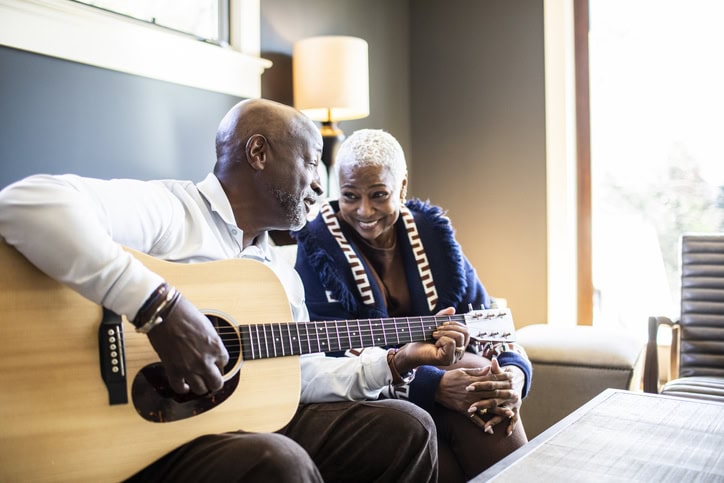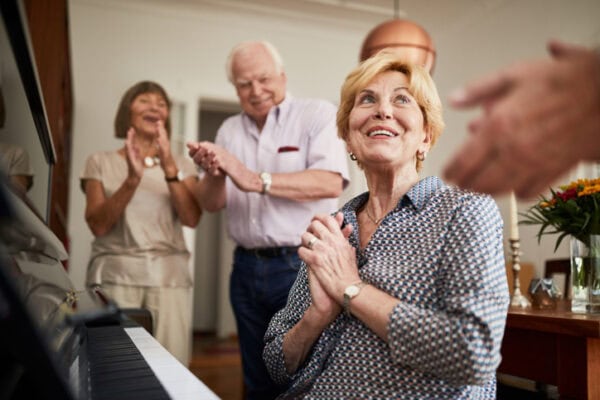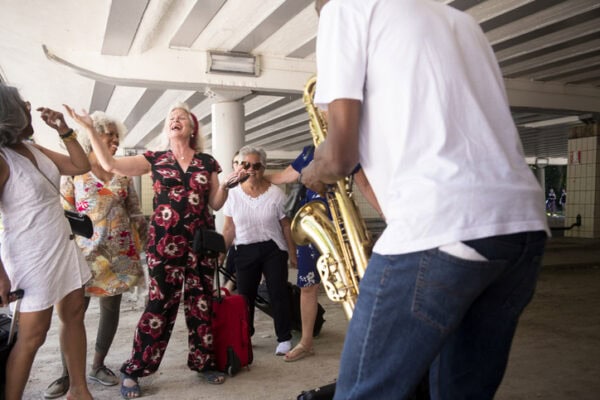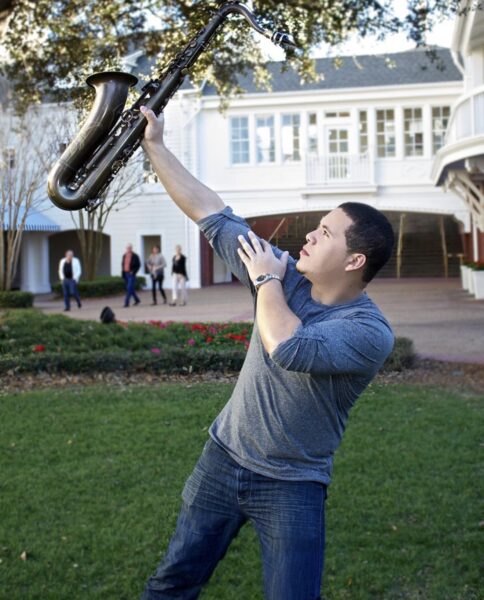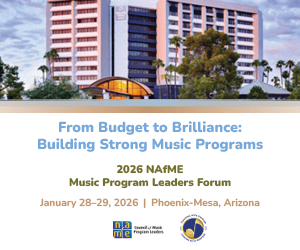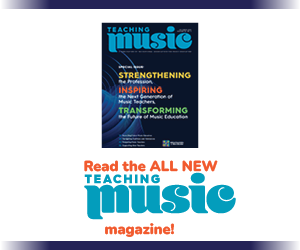/ News Posts / The Deeper Role of Music in Senior Living
The Deeper Role of Music in Senior Living
By NAfME Member José Valentino Ruiz, Ph.D. and Jesse Tillman Pitts
Abstract
This article applies Jesse Tillman Pitts’s TILLMAN Framework to the context of senior living, demonstrating how music can move beyond recreational programming to become a vital practice of community-building. Through trust, innovation, listening, leadership, mentorship, accountability, and nurturing, music transforms assisted living environments into spaces of belonging, purpose, and flourishing.
Beyond “Activity Programming”
In many assisted living and senior living facilities, music is often filed under the heading of “recreational activity.” A pianist is brought in for an hour, a singalong of golden oldies fills the lounge once a month, or a volunteer choir performs seasonal carols. These moments are pleasant, but they rarely tap into the full power of music. Too often, music is seen as a way to pass time rather than a way to transform community.
This is a missed opportunity. According to Pitts’ (2025) study, the real value proposition of senior living is not found in checklists of amenities but in cultivating human connection. Music, more than almost any other practice, is uniquely suited to make that vision tangible.
Music is not merely entertainment; it is relational. It is memory made audible, culture embodied, and joy shared. For seniors, music can be a lifeline to the past, a bridge to younger generations, and a spark of creativity in the present. When guided by the TILLMAN Framework, music becomes more than a pleasant diversion—it becomes a vehicle for trust, innovation, listening, leadership, mentorship, accountability, and nurturing within senior living communities.
Framing the Question
What might it look like if assisted living facilities treated music not as background programming but as a core practice of community-making? What would change if administrators, staff, and residents alike used the TILLMAN Framework as a guide for building music-based community? The sections that follow explore each element of the framework through real and imagined scenarios, offering a blueprint for transforming senior living through music.
T – Trust: Building Safe Musical Environments
Principle: People engage fully when they feel safe.
In senior living, trust is not optional—it is essential. Residents are often vulnerable, whether due to physical health, memory loss, or the emotional challenges of transition. For music to be more than surface-level entertainment, it must operate in an environment of trust.
Examples in Practice:
- In a memory care unit, a facilitator leads a familiar hymn sing. Residents, even those with advanced dementia, hum along because they trust that the songs will not expose their memory lapses but instead affirm what remains within them.
- In a drumming circle, no one corrects a misplaced beat. The environment is framed as playful and experimental. Trust grows because residents know they cannot “fail.”
- Staff members join the music-making, not as supervisors but as participants. A nurse sits in with a tambourine, laughing when her rhythm falters. The act of playing together communicates that everyone belongs.
Why It Matters:
Trust turns music from a passive activity into a shared human experience. When residents trust that their contributions are welcomed, they step into deeper participation. This builds confidence, combats isolation, and strengthens bonds between residents and staff.
I – Innovation: Reimagining Musical Programming
Principle: Communities flourish when programs adapt creatively to real needs.
Senior living music programming too often falls into predictable ruts: piano recitals, seasonal choirs, occasional visits from outside musicians. While these are valuable, they can be unimaginative. Innovation asks: How can music-making be reinvented to meet the evolving needs of residents today?
Examples in Practice:
- A facility creates an intergenerational ensemble, inviting local high school students to rehearse weekly with residents. Together they prepare concerts that showcase both classical standards and contemporary pop hits.
- A resident songwriting workshop uses tablets and music apps so even those with limited mobility can compose new melodies. One resident, who can no longer play the violin due to arthritis, beams as her string arrangement is realized digitally.
- Instead of only bringing performances to residents, communities develop “resident-led concerts,” where residents select themes—“Songs of our Hometowns” or “The Soundtrack of 1968.” Their input directs the creative process, giving ownership and dignity.
Why It Matters:
Innovation keeps music alive and relevant. It reminds residents that they are not only consumers of culture but creators of it. Innovative programming validates their agency and ensures that music remains a living, breathing part of their community.
L – Listening: Honoring Voices and Stories
Principle: Connection begins with listening—musically and personally.
In assisted living, listening is not just about tuning to the right pitch but about tuning to people’s lives. Residents carry histories, memories, and identities that can be unlocked through careful listening.
Examples in Practice:
- A facilitator begins rehearsal with the question: “What song from your youth feels most like home?” Responses guide the repertoire, ensuring it resonates personally.
- Personalized playlists are developed for residents with dementia. A woman who rarely speaks suddenly sings word-for-word when she hears a beloved jazz standard from her teenage years.
- During a jazz trio performance, musicians pause between pieces to ask residents for their favorite stories connected to the music. One man recalls dancing with his late wife to “In the Mood,” transforming the concert into a shared narrative experience.
Why It Matters:
Listening validates identity. It communicates that residents are not anonymous members of a program but individuals whose stories matter. In turn, music becomes a mirror reflecting back their lives.
L – Leadership: Empowering Residents as Leaders
Principle: Leadership shapes culture and fosters ownership.
Too often, residents in assisted living are positioned only as recipients of care. Music offers an avenue to flip this script, empowering residents to step into leadership roles.
Examples in Practice:
- A retired choir director living in the facility is invited to conduct rehearsals once a month. Her leadership is not symbolic; it actively shapes the ensemble’s sound.
- Residents take turns leading warm-ups, choosing the day’s first song, or introducing pieces at concerts.
- Resident committees collaborate with staff to plan the music calendar, ensuring that programming reflects their preferences and cultural heritage.
Why It Matters:
Leadership cultivates dignity. It allows residents to remain contributors, not merely consumers, within their community. Through leadership, music becomes not just something they receive but something they help shape.
M – Mentorship: Passing Music across Generations
Principle: Mentorship deepens connection and gives purpose.
Senior living communities are filled with wisdom, talent, and experience. Music offers a natural platform for mentorship, both peer-to-peer and across generations.
Examples in Practice:
- Residents with musical backgrounds mentor local youth in singing folk songs, teaching basic chords, or sharing performance insights.
- A partnership with a nearby university places music education students in weekly practicum sessions at the facility. The students learn pedagogy and empathy; residents rediscover purpose as mentors.
- Residents mentor each other: One teaches ukulele to peers, another demonstrates harmonica, another shares her skill in gospel singing.
Why It Matters:
Mentorship reverses the deficit narrative of aging. Rather than being defined by decline, residents are recognized as bearers of culture and teachers of the next generation. This sense of purpose enhances well-being and strengthens community bonds.
A – Accountability: Sustaining Connection through Reliability
Principle: Trust and connection endure only when accountability is present.
Residents in assisted living know when promises are broken. Cancelled events, inconsistent schedules, or superficial commitments erode confidence. Accountability ensures that music is treated not as filler but as a dependable pillar of community life.
Examples in Practice:
- Staff honor rehearsal and performance schedules consistently, reinforcing the message that residents’ time is valued.
- A resident choir adopts shared norms: Each member commits to attending rehearsals and supporting one another. Accountability is mutual, not imposed.
- Administrators protect arts budgets even under financial pressure, signaling that music is a core commitment, not a dispensable extra.
Why It Matters:
Accountability reinforces respect. When music programs are dependable, residents learn to trust not only the music but the community itself.
N – Nurturing: Enriching Life beyond Performance
Principle: Nurturing is about human flourishing, not polished products.
The ultimate goal of music in senior living is not perfection but enrichment of life. Nurturing recognizes that music is not about producing flawless concerts but about cultivating joy, identity, and connection.
Examples in Practice:
- Music therapists adapt sessions for individual needs: rhythmic exercises that support motor skills, singing that reduces anxiety, improvisation that sparks laughter.
- A choir performs not only in public concerts but also informally in hallways and dining rooms, filling daily life with sound.
- A resident who stopped playing piano years ago is gently reintroduced through duets with staff, rekindling confidence and joy.
Why It Matters:
Nurturing humanizes senior living. It shifts music from a checklist to a lifeline, reminding residents that they are still capable of growth, creativity, and joy.
Broader Implications: Rethinking Senior Living through Music
For Administrators
Integrating the TILLMAN Framework through music requires institutional commitment. It demands budgets for music staff, training for non-music staff to participate, and scheduling that prioritizes music not as an “extra” but as a core aspect of life.
For Staff
Music can be a tool for building stronger relationships with residents. When staff join drumming circles or sing alongside residents, they reinforce bonds of trust and mutual humanity.
For Families
Families often see music as a sign of life within a community. When they witness residents thriving musically—leading, mentoring, nurturing—they see evidence that their loved ones are not simply being housed but are truly living.
For Society
Reframing music in senior living contributes to broader conversations about aging. It challenges stereotypes of decline and instead presents seniors as cultural leaders and creative citizens.
Music as the Heartbeat of Community
The TILLMAN Framework offers a powerful way to reposition senior living around human connection. When applied through music, it transforms communities: Trust flourishes, innovation abounds, listening deepens, leadership emerges, mentorship multiplies, accountability stabilizes, and nurturing enriches daily life. In the end, music in senior living is not about perfect concerts or polished performances. It is about building communities where residents feel known, valued, and connected. Music gives voice to memory, rhythm to relationships, and harmony to belonging. As Jesse Tillman reminded us in his original article, community is the true differentiator in senior living. Music is one of the most profound ways to make that community audible, visible, and alive.
Reference
Pitts, J. T. (2025, August 16). Community as a differentiator: Repositioning senior living around human connection using the TILLMAN framework. Journal of Community Entrepreneurship, Leadership & Innovation.
About the authors:
NAfME member José Valentino Ruiz, Ph.D. is a scholar, cultural entrepreneur, and performing artist whose work integrates music, research, and global leadership. His career spans more than 1,400 international performances as a multi-instrumentalist, the production of over 150 albums, and original compositions for film and documentary projects. As an author and editor, he has contributed to more than 200 publications on topics including music business, arts entrepreneurship, pedagogy, and cultural diplomacy, while also founding Berisheet Press, an academic publishing platform for interdisciplinary journals at the intersection of creativity, commerce, and ministry. Appointed by the U.S. Department of State as the first U.S. Speaker on Creative Economy and Global Arts Entrepreneurship, he partners with governments, NGOs, and universities around the world to advance the role of the arts in economic development and intercultural exchange. His work reflects a commitment to uniting artistry and scholarship with service, preparing future generations to view music not only as performance but as a vehicle for transformation and community.
Inspired by the work of distinguished NAfME lifetime member Dr. Victor Fung and Lisa Lemberg who released a book on lifelong learning focusing on the way music can be learned and facilitated in retirement communities, Ruiz collaborated with Jesse Tillman Pitts on this work.
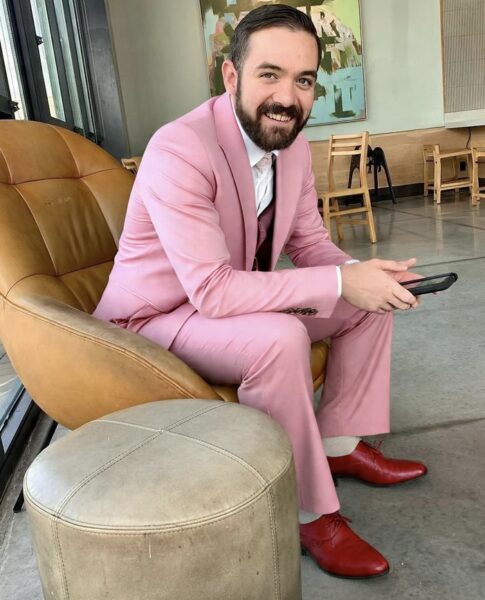 Jesse Tillman Pitts, M.B.A. is a senior living executive, consultant, and writer whose career spans caregiving, regional leadership, and strategic consulting. He is the founder of Aravine Consulting and serves as Regional Director at Angels Senior Living, where he focuses on cultivating resident-centered communities and strengthening organizational culture. His scholarship and thought leadership have appeared in the Journal of Community Entrepreneurship, Leadership & Innovation, the Creativity and Commerce Journal, The Vanguard: A Media Journal on the Arts, Music, and Global Culture, and the Journal of Creative Strategy, Systems, and Relations. With a focus on innovation, workforce development, and the role of human connection in assisted living, Pitts contributes to advancing dialogue across fields of senior care, entrepreneurship, and the creative industries.
Jesse Tillman Pitts, M.B.A. is a senior living executive, consultant, and writer whose career spans caregiving, regional leadership, and strategic consulting. He is the founder of Aravine Consulting and serves as Regional Director at Angels Senior Living, where he focuses on cultivating resident-centered communities and strengthening organizational culture. His scholarship and thought leadership have appeared in the Journal of Community Entrepreneurship, Leadership & Innovation, the Creativity and Commerce Journal, The Vanguard: A Media Journal on the Arts, Music, and Global Culture, and the Journal of Creative Strategy, Systems, and Relations. With a focus on innovation, workforce development, and the role of human connection in assisted living, Pitts contributes to advancing dialogue across fields of senior care, entrepreneurship, and the creative industries.
Did this blog spur new ideas for your music program? Share them on Connect! Interested in reprinting this article? Please review the reprint guidelines.
The National Association for Music Education (NAfME) provides a number of forums for the sharing of information and opinion, including blogs and postings on our website, articles and columns in our magazines and journals, and postings to our Connect member portal. Unless specifically noted, the views expressed in these media do not necessarily represent the policy or views of the Association, its officers, or its employees.
Published Date
September 4, 2025
Category
- Innovation
- Lifelong Learning
Copyright
September 4, 2025. © National Association for Music Education (NAfME.org)
